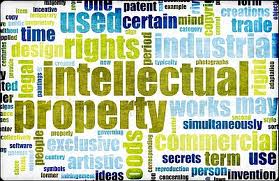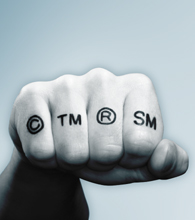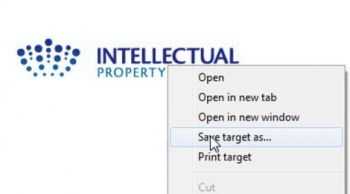Intellectual Property
Intellectual Property (IP) is a legal concept that refers to creations of the mind for which exclusive rights are recognized under law and precedent. Under intellectual property law, owners are granted certain exclusive rights to a variety of intangible assets that can be described explicitly. Assets that can be considered intellectual property include, but are not limited to: musical, literary, and artistic works, discoveries, inventions, words, phrases, symbols, and designs[1]. Common types of intellectual property rights include copyright, trademarks, patents, industrial design rights, and (in some jurisdictions) trade secrets. Although many of the legal principles governing intellectual property rights have evolved over centuries, it was not until the 19th century that the term "intellectual property" began to be used, and not until the late 20th century that it became commonplace in the majority of the world.
Contents
Definition
Intellectual property can be protected under the law. This means there are a number of IP rights that enable owners to limit the use or interpretations of his/her IP. These protections can come in the form of patents, trademarks, industrial designs, geographic indications of source, and copyrights[2].
IP is becoming an increasingly important aspect of societal governance as developments and innovations become more or fully dependent on technologies. Without intellectual property rights there would be no way for a person to protect his/her intellectual property on the internet, where creations/ideas/etc are almost never associated with a person's real life identity because of the anonymity of the internet.
Patent
A patent in the United States is defined by the U.S. Patent and Trademark Office (PTO) as "The grant of a property right to the inventor." A patent grant confers upon the owner "the right to exclude others from making, using, offering for sale, selling, or importing the invention."[3] The duration of patent protection depends on the type of patent granted:
- Design Patents - 15 years (if application was filed after May 13, 2015)
- Utility & Plant Patents - 20 years from the date on which the patent application was filed
Trademark
A trademark in the United States, as defined by the U.S. PTO, is "Any word, name, symbol, or device, or any combination, used, or intended to be used, in commerce to identify and distinguish the goods of one manufacturer or seller from goods manufactured or sold by others." Trademarks do not expire after a set term of years, nor is registration mandatory. The rights provided by Trademarks come from actual "use", allowing them to last forever. [4]. Issues with trademarks come in the form of direct trademark infringement, trademark dilution, and initial interest consumer confusion.
Direct trademark infringement is directly taking another company or manufacturer's trademark for personal or economic gain. Examples of direct trademark infringement include taking a logo or a domain name. Trademark dilution occurs when a small change has been made to a registered trademark such that the original trademark becomes blurred or tarnished. Initial interest consumer confusion is a phenomenon that involves what is called bait and switch. This occurs when a consumer heads to a store or website thinking it belongs to a specific company, only to leave or go to another website because they realized that they weren't where they wanted to be.
Copyright
A copyright is a form of protection granted to the authors of "original works of authorship," both published and unpublished. A copyright protects a tangible form of expression rather than the idea or subject matter itself. Several factors influence the duration of copyright protection. Individually created works are granted protection for the lifetime of the author, plus an additional 70 years. Works created anonymously, pseudonymously, and for hire are guaranteed protection for the shorter of the two: 95 years from the date of publication or 120 years from the date of creation. [5]
Trespass to Chattels
Trespass to chattels occurs when a user doesn't intend to use a website or server for its intended purpose and crawls the site or server for personal gain. Examples of trespass to chattels includes crawling an aggregator site without intending to make a purchase. This is cause for concern to the site owners and users because too many users on a site causes the site to slow down and crash, affecting the quality of service for those intending to make a purchase.
Intellectual Property versus Physical Property
Intellectual property differs from physical property due to the nature of how it is accessed and utilized. This has implications for defining terms under which IP can be protected[6].
Two major distinctions between IP and physical property are made by information philosopher and professor Luciano Floridi. He states two main points:
1. IP has no limitations on reproducibility. Unlike physical property where there are constraints on how many copies of a property exists, IP is virtually limitless. An example of this a song; an artist considers a new song he/she creates to be his/her IP, but any number of individuals can play this song and reproduce the same chord progressions on their own instruments.
2. IP can be used simultaneously by multiple people. The point at which it is deemed immoral and illegal to use someone else’s physical property without permission is when that property has to be physically taken away from its rightful owner, depriving the owner of using it. With IP the authorized and the unauthorized user can have access to the property at the same time (i.e. downloading software for free).
Due to this differentiation between intellectual property and physical property, an augmented legal structure for the protection of IP is necessary.
History
The concept of intellectual property dates back as far as 500 BC, "when chefs in the Greek colony of Sybaris were granted year-long monopolies for creating particular culinary delights." Two more examples of IP occurred in Roman times but were not common occurrences for this era. The origins of patent law and copyright can be traced back to 15th-century England with the "Statute of Monopolies" of 1624 and the "Statute of Anne" of 1710. The American system of IP rights is based off of the English system[7].
IP Law in the United States
After gaining independence from Great Britain, copyright law was passed by 12 of the 13 colonies, with the exception of Delaware. Patent law dates back earlier than the legislation of the United States Constitution, where each of the 13 colonies had their own distinct body of patent law. A patent granted in one state did not necessarily grant the owner protection in a neighboring state. This posed many potential problems, including the degradation in value of patents and copyrights, which led to the declaration in the Constitution that intellectual property law should be under the jurisdiction of the federal government and not the state government. Federal law grants courts exclusive jurisdiction in most intellectual property cases. Giving federal courts full authority to hear cases over intellectual property matters, instead of state courts, is an effort to promote uniformity in intellectual property law. [8]
Importance of Intellectual Property
Notable driving factors for the regulation of intellectual property rights relate back to John Locke’s original conceptualization of property in his Second Treatise. Locke explains that the value placed on an object is dependent on the existence of a society[9]. Within modern society IP is valued because of its contribution to societal progress. The importance of IP resides in incentivizing innovation so that utility is maximized and inventors are recognized for their contributions to society and rewarded for their efforts.
In regards to economic growth, human knowledge accumulates with every new invention or product, in turn, decreasing the cost of innovation. The rate of growth of an economy will directly correlate with the rate of introduction of new products. Therefore, creating an environment favorable for the accumulation of human knowledge through intellectual property rights will result in an increase in innovation and economic growth.[10]
Protection of Intellectual Property
IP is protected under a number of regulations that need to be consistent internationally in order to be successful. Organizations such as the World Intellectual Property Organization (WIPO) exist in order to create the uniformity[11]. Additionally, the Patent Cooperation Treaty (PCT) provides a multitude of benefits to applicants who are seeking international protection. With 152 PCT Contracting States, applicants can simultaneously seek protection in a large number of countries after filing one international patent application under PCT.[12]
Creative Commons is another organization that seeks to protect online IP while preserving internet users' abilities to innovate and share resources and online mediums[13]. IP protected by a Creative Commons license will have this logo on or near it: ![]()
Ethics
Ethical Concerns About Intellectual Property
Concerns relating to ethics and intellectual property protection stem from holders of IP desire to broaden the scope of IP rights in order to capitalize to greater extents on the content of their IP products. IP rewards the creators by making penalties for imitating their creation. This stimulates innovation, serving as the foundation of innovation, because inventors know that their idea will be safe from being copied and thus invest in research to yield results [14]
From the perspective of users of company owned IP (i.e. software users) there are ethical concerns regarding the payment for use of these intellectual properties due to the ease of duplication and implementation. For technological intellectual property products such as software, companies have tried to increase the scope under which their products are protected from free use. Such practices include the use of licensing softwares[15].
However, there is also a danger of too strong patents. Excessive patents make successive innovation more costly. This comes primarily from having to seek permission on each step along the way. Firms seek patents because it helps enhance their revenue as well as to better establish themselves in the market. While many enterprises share this mission, this makes it harder for smaller firms to enter the market. This as a result, discourages innovation.
What is concerning about IP is that sometimes it is difficult to understand who owns what regarding IP. Often times an employee of a company who creates something while at the company, even if it is not for the company, has a signed contract that says that all creations are property of the company, and not the individual who makes it. LegalHero says that there are many ways for contracts to be changed with specific language that changes the ownership of intellectual property and especially as independent contractors do they have issues with this.[16] Those going into the tech workforce and who work with information must have a stronghold on their IP and keep it in their legal control vice the company they work for. As a company owner, however, the edge in a marketplace may be a certain type of IP that is unusable by others (Copyrights, Patents).
An example of misuse of IP protections such as patents can be seen in the practice of "patent trolling"[17]. Patent trolling is a term for the practice of "enforcing patents on one or more infringers in an aggressive manner" with opportunistic motivations and no intention of using the patented property for its allocated purpose. This is an ethical concern relating to intellectual property because there are concerns of misuse of the protections put in place to help promote innovation used solely for the financial gains of those who hold patents.
Ethical issues have presented themselves in issues of initial interest consumer confusion. Some cases have argued that the switch in bait and switch is simply free speech, particularly in cases of taken domain names. When a consumer makes a decision to move to another page, some argue that is their respective freedom to do so.
Famous Intellectual Property Cases
A&M Records v. Napster Inc.
In 2000, Napster Inc, a music file sharing company, was brought to the U.S. Court of Appeals by major record labels. Famous record label, A&M Records sued Napster Inc for copyright infringement for allowing users to search and download MP3 files from other users' computers. Napster Inc had accumulated a user base of 20 million users, and the website allowed users to share any number of music files online. As a result, a San Francisco judge ordered Napster to close its free file sharing capabilities. Napster Inc filed for bankruptcy and eventually re-emerged as a paid online music service [18].
eBay v. Bidder's Edge
In May 2000, eBay filed suit against Bidder's Edge, an aggregator, and sought an injunction against them to prevent trespass on eBay's site by trespass to chattels. In the lawsuit, eBay outlined Bidder's Edge's behavior in making "spiders" or "robots" to crawl eBay's website to gather information and aggregate it on their own website, and stated that because of this behavior, there was potential future damage to eBay's business. Ebay stated that when robots crawled the site, it would slow the site down, possibly crash it, and disrupt the services for people who were there to purchase something. The courts sided with eBay, and a preliminary injunction enjoined Bidder's Edge for trespassing eBay's site [19].
Future Implications of Intellectual Property
Intellectual property rights are increasingly a topic of discussion as it relates to information technologies. The question is whether or not IPs should be accessed freely or some type of law enforcement should exist to curb IP "theft." Basically, should there be an "Internet police" that is responsible for protecting intellectual property on the Internet from being stolen or illegally used? This is obviously a complex matter, where one solution is almost impossible as it seems like it is impossible to police the entire Internet.
See Also
References
- ↑ Definition of Intellectual Property Rights http://www.brighthub.com/office/entrepreneurs/articles/39140.aspx
- ↑ What is Intellectual Property? http://www.wipo.int/about-ip/en/
- ↑ United States Patent and Trademark Office Website: Patent Information http://www.uspto.gov/patents/index.jsp
- ↑ United States Patent and Trademark Office: Trademarks Information http://www.uspto.gov/trademarks/index.jsp
- ↑ United States Patent and Technology Office Website: Trademark, Patent, and Copyright Definitions http://www.uspto.gov/trademarks/basics/definitions.jsp
- ↑ "Copyright and Digital Media in a Post-Napster World" by GartnerG2 and the Berkman Center for Internet and Society at Harvard Law School http://si110.cms.si.umich.edu/sites/si110.cms.si.umich.edu/files/IntellecProp/Gartner+Harvard_on_IP.pdf
- ↑ Stanford Encyclopedia of Philosophy: "Intellectual Property" http://plato.stanford.edu/entries/intellectual-property/#HisIntPro
- ↑ History and Success of Intellectual Property Law https://nationalparalegal.edu/public_documents/courseware_asp_files/patents/IntroIP/History.asp
- ↑ John Locke's Second Treatise, Chapter 5: Of Property http://www.constitution.org/jl/2ndtr05.htm
- ↑ The Role of Intellectual Property Rights on Economic Growth http://www.sciencedirect.com/science/article/pii/0304387895000399
- ↑ What is WIPO? http://www.wipo.int/about-wipo/en/
- ↑ PCT http://www.wipo.int/pct/en/
- ↑ About Creative Commons http://creativecommons.org/about
- ↑ http://www.kauffman.org/what-we-do/resources/entrepreneurship-policy-digest/how-intellectual-property-can-help-or-hinder-innovation
- ↑ NY Times: "The Tyranny of Copyright" http://si110.cms.si.umich.edu/sites/si110.cms.si.umich.edu/files/IntellecProp/Copyright_Tyranny.pdf
- ↑ [1]
- ↑ Wikipedia: Patent Troll http://en.wikipedia.org/wiki/Patent_troll
- ↑ Top Four High Profile Cases in Intellectual Property Law https://blog.oup.com/2014/11/intellectual-property-law-cases/
- ↑ eBay Inc. v. Bidder's Edge Inc. https://www.casebriefs.com/blog/law/intellectual-property-law/intellectual-property-keyed-to-merges/state-intellectual-property-law-and-federal-preemption/ebay-inc-v-bidders-edge-inc/


